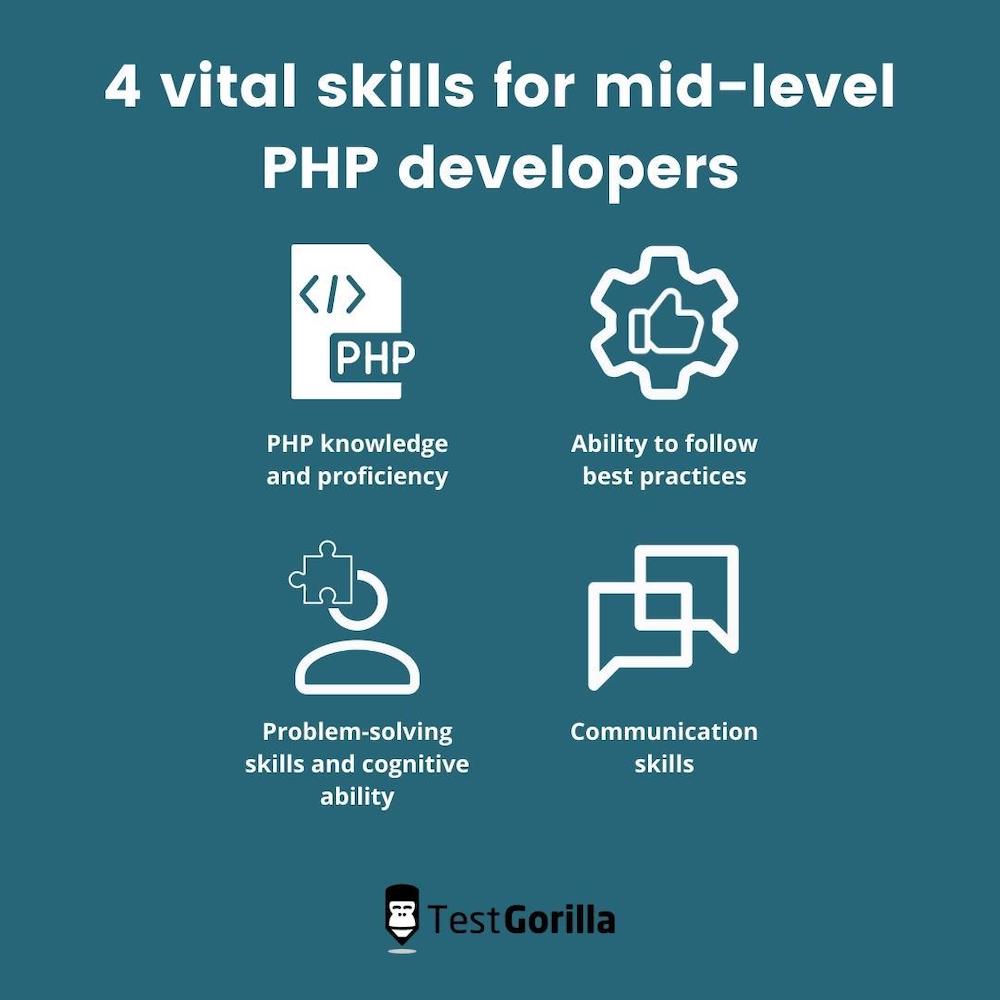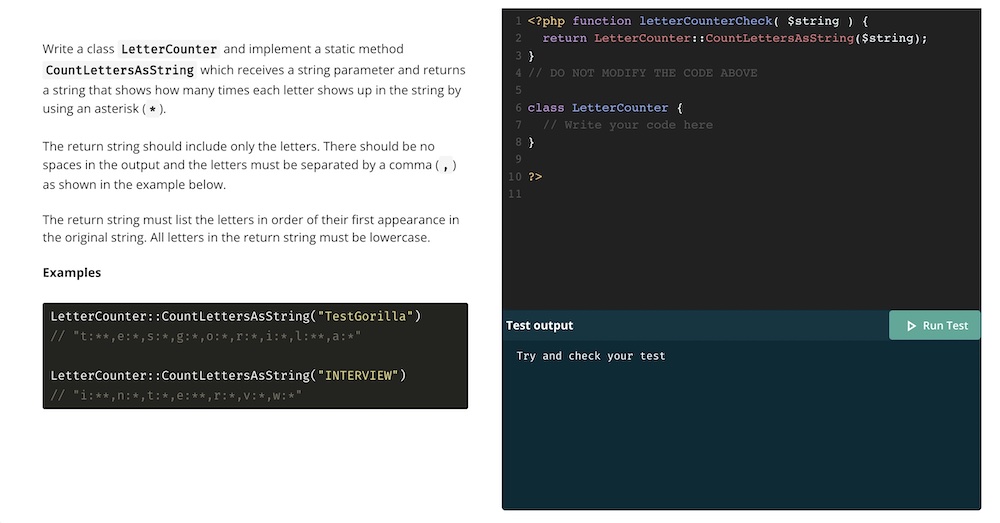Today, tech talent is in higher demand than ever. You’ve probably noticed listings for software developers and engineers dominating job boards globally – Cyberstates predicts 178,000 net new tech jobs in 2022, and the projected growth rate for tech jobs over the next decade is almost twice the overall national jobs rate.
How has this come to be? Well, the pandemic has accelerated digital transformation at unprecedented rates. Reuters CEO Steve Hasker has claimed that we saw three to four years of progress in just the first few months of 2020, whilst Forbes supposes that 10 years of digital growth have been compressed into two.
In line with this growth, PHP developers are in high demand. Many companies use PHP (PHP: Hypertext Preprocessor) for server-side web and application development because of its ease and flexibility, so it’s an important language for developers to know.
Sadly, It’s becoming harder for companies to find and hire top tech candidates: The tech industry has been most affected by talent shortages because the demand for tech talent is so high.
TestGorilla is here to solve this problem. We believe that a transforming world of work needs and deserves transformed recruitment practices, and we’re here to help companies use skills-based strategies to find and hire the tech talent they need. Read on for our guide to recruiting top mid-level PHP developers for your organization.
What does a mid-level PHP developer do?
If you’re looking to hire a mid-level PHP developer for your business, it’s likely that your organization’s website or application’s back-end has been programmed in the language. If so, its upkeep will depend on a team of developers and engineers who are skilled in PHP and any other coding languages used on the site’s user and server sides.
Mid-level developers are at the center of most of these teams and should be able to use PHP to solve problems for websites and applications. They are more skilled and experienced than a team’s junior developers, but less so than senior developers, who tend to lead engineering efforts.
Opinions vary on exactly how skilled or experienced each kind of developer is, but generally:
Junior developers have one to three years of development experience. They are proficient in one or two languages and a couple of relevant frameworks. Usually, junior developers will only have back-end or front-end expertise. They won’t have management experience, and will just be expected to manage themselves.
Mid-level developers will have three to five years of experience, or a degree in computer science (or a related subject) and a couple of years’ worth. They should be masters in two or three languages and frameworks. Some companies expect their mid-level developers to have full-stack expertise, but lots of mid-level developers specialize in either front or back end. It’s unlikely that they’ll have management experience.
Senior developers will have five or more years of experience working in development. They should be proficient in most modern coding languages or should be able to pick up anything new quickly. Most senior developers have experience in team or project management, so they should also have great architecting and communication skills.
Some organizations will find this way of categorizing developers too restrictive, so make sure you’ve really thought about which kind of engineer you want to hire and what you need them to be able to do. DEPT agency recommends companies think about it in terms of contributors, architects, and managers as an alternative to junior, mid-level, and senior.
Regardless of how your team is structured, one thing is always important: Write an effective job description that lists all the roles and responsibilities of the position. This way, whether your candidates are qualified for junior, mid, or senior development roles, they’ll know whether they’re qualified and, if they are, exactly what to expect.
Typical mid-level PHP developer roles and responsibilities include:
Writing clean, fast, and high-quality PHP scripts; ensuring they’re scalable, and delivering them on time
Testing, troubleshooting, and maintaining software and databases so that websites and applications run smoothly
Working to specifications to improve the code-base and optimize the performance of websites and applications
Follow industry and PHP best practices to contribute to development lifecycles
4 vital skills for mid-level PHP developers
PHP knowledge and proficiency
With a few years of experience and possibly a relevant degree under their belt, mid-level PHP developers should be masters of PHP. They’ll have a firm grasp of the language and its operations and functions, and it’s likely they will have built and maintained applications in PHP before.
This seems obvious, but it’s a vital skill for mid-level PHP developers to have, and it’s not guaranteed by education and experience. The latest versions of PHP are object-oriented, so aim to hire developers who have object-oriented programming knowledge and skills.
Mid-level PHP developers should also be able to use some PHP frameworks effectively: Laravel, Symfony, CodeIgniter, and Zend are some examples. You should look to hire a developer who knows the language and some of its relevant frameworks inside out, and who can show you that they do by doing well in a coding skills test.
Ability to follow PHP best practices
Because PHP has been around for such a long time, it has been adjusted and updated many times. This is definitely one of its perks: The language has been continuously refined by a growing community of developers. However, it means that there’s lots of outdated information about PHP floating around the internet.
This is easily combated. Top mid-level PHP developers will know which living documents to use to keep their coding practice up to date. They’ll also be able to follow some general best practices, such as:
Making their code concise and readable, and documenting it properly
Making the most of core functions and classes by checking the PHP manual before creating functions
Using the PHP Standard Recommendations (PSR) to standardize programming concepts
Using a good text editor to avoid syntax errors
Keeping code snippets to save time
Creating a master configuration file for database connection settings
Turning on error reporting in the development stages of site-building
Problem-solving skills and cognitive ability
Problem-solving skills are vital for all developers: They’re at the core of programming as a concept and practice. Computer programmers are problem-solvers first and foremost, and scripting, no matter the language, is the vehicle for their adventures in problem-solving.
In light of this, great PHP developers don’t just know and use PHP. They leverage their PHP skills and knowledge as a means of finding a solution to a problem. This requires a high degree of cognitive ability – as any programmer will tell you, software development is a mentally intensive field of work, and it’s also more creative than people realize.
Problem-solving skills and excellent cognitive abilities will be the difference between average candidates and top talent. Soft skills are impossible to gauge from CVs and resumes, so you should assess candidates using skills tests and interviews to hire top mid-level PHP developers.
Communication skills
Communication is a vital soft skill in all fields of work. Effective communication is the lifeblood of successful teamwork dynamics, and statistics show that nearly 70% of the workforce would be more productive if workplace communication improved.
But how is it important for software development teams specifically?
Good communication is a vital skill for developers because there will likely be a knowledge gap between what engineering teams know and what the rest of the organization knows about how the company’s website or application functions.
As well as communicating with other developers, mid-level PHP developers will often have to explain their processes to colleagues who have little-to-no knowledge of coding. Hiring candidates with great communication skills is a great way to ensure effective communication and collaboration between, as well as within, different teams.
The best insights on HR and recruitment, delivered to your inbox.
Biweekly updates. No spam. Unsubscribe any time.
5 steps to hiring the best mid-level PHP developer
Now we’ve covered some key skills, let’s break down a recruitment strategy. Follow these five steps to hire a mid-level PHP developer without bias or stress.
1. Write and post a great job description
If you’ve just read our section explaining the kind of skillset a mid-level PHP developer should have, then hopefully by now you’ll have a vague idea of what a great candidate looks like.
The next thing to do is take these thoughts and channel them into a great job description for the mid-level PHP developer role with your company. This should be clear, concise, and informative: If you don’t write a posting that is attractive to top talent, they simply won’t apply. Fall short at this first hurdle, and your entire recruitment process is compromised.
So, what does a great mid-level PHP developer job description look like? Firstly, it should contain the following:
Details about the advertised role, including responsibilities, hours, compensation, location, and some details about the relevant team. Be transparent about the recruitment process, too: If you’re going to give your applicants skills assessments, let them know.
Specific requirements for the role. Explain which PHP frameworks you require proficiency in – if your engineers use Laravel, then say so. Remember that this is a mid-level role, so you can seek candidates with degrees or specific experiences, although you should focus on skills first and foremost
Some information about your company or organization. You should be looking to hire somebody who shares your company values and aligns with the mission of your business. Put some heart into this, and hopefully, you’ll attract candidates who love what you do.
This is a good general outline to follow, however, because the world of work is changing, specifics will be important. Does your company offer remote working days? Are you planning a shift to a four-day working week? Perhaps you’re implementing a 9/80 work schedule?
To attract top talent you’ll also have to offer competitive compensation. You should be transparent about wages straight away.
Salaries for PHP developers differ between companies and locations, so you’ll need to do some research. To get you started, below is a table showing average PHP developer salaries in the US according to various sources.
Source | Average annual salary | Lowest | Highest |
Glassdoor | $81k | $55k | $100k |
PayScale | $64k | $43k | $94k |
ZipRecruiter | $86k | $16k | $137 |
2. Send your applicants a complete pre-employment assessment
Pre-employment assessments are the best way to reliably hire candidates who have the PHP development skills you’re looking for. The future of hiring is skills-based, so you should be using online tests to make data-driven recruitment decisions if you aren’t already.
Beyond the obvious advantage of focusing on skills, pre-employment testing helps tackle the hiring biases that CV-based recruitment practices are open to. By removing the emphasis on education and degree requirements, you can unlock access to a rich pool of talent that is often overlooked.
All companies have different needs, of course, but as they write job descriptions and assess candidates they should carefully assess the value of the blunt and outdated instruments that they’ve been using, and the assumptions they’ve been making.
Harvard Business Review, ‘Skills-Based Hiring is on the Rise’ (2022)
With TestGorilla, you can build a complete pre-employment assessment for your candidates using up to five tests from our test library as well as any custom questions you want to add. We recommend using a selection of the following tests to identify the best mid-level PHP developer candidates.
PHP (coding): Object-Oriented Programming test
To evaluate your candidates’ object-oriented programming skills, you should give them a PHP (coding): Object-Oriented Programming test. This will effectively evaluate their ability to use PHP specific functions
The test will measure your applicants’ coding skills by giving them a short coding assignment. They’ll be given 30 minutes to implement a code that meets certain requirements. When a candidate enters the test, they’ll see something like this:
This test is specifically geared towards mid-level developers, so it’s ideal for vetting applicants for this role.
For more advanced roles, use our PHP (coding): Intermediate-Level Algorithms test. Candidates who excel will be skilled intermediate-level PHP developers – they’ll have a strong grasp of PHP programming concepts. You can use this one to hire senior developers: Only the best of the best will score highly.
Clean Code test
Any software developer worth their salt should be able to write clean code that is easy to maintain. Ensure you hire someone who can write and implement code effectively using TestGorilla’s Clean Code test. It covers:
SOLID design principles
Code Simplicity
Code Readability
Software Design Principles
At least one cognitive ability test
Our test library has multiple cognitive ability tests you can use. For mid-level developer candidates, we suggest at least one of the following.
The Problem-Solving test is a reliable way to evaluate your candidates’ ability to define problems and analyze data to reach sound decisions about solutions
Our Attention to Detail (textual) test assesses candidates’ ability to pay attention to textual details whilst working with and processing information
Use TestGorilla’s Critical Thinking test to identify applicants who have sharp analytical skills
Other technical tests based on your organization’s tech stack
Programming skills requirements will vary based on a company’s tech stack, a term used to describe which software, coding languages, programs, tools, and services they’re using to build their site or application. PHP, for example, features in many companies’ tech stacks.
There’s a lot of tech out there, so tech stacks vary. At TestGorilla, we have a growing selection of programming skills tests, so we can cater to a variety of companies and their respective tech stacks. You can assess:
PHP framework skills with the Laravel test
SQLite database skills with SQLite (coding): Complex Queries, SQLite (coding): Entry-Level Database Operations, and SQLite (coding): Intermediate-Level Querying tests
Other programming language skills using the CSS test, the HTML5 test, or the JavaScript (coding): Data Structures and Data Types test
A personality and culture test
Give your candidates a Culture Add test to assess how their values align with your company’s
The Enneagram test maps candidates’ personalities in a nine-pointed diagram that describes their core beliefs and worldviews
TestGorilla’s innovative Motivation test can help you identify candidates whose expectations align with the role you’re offering
Use the 16 Types test to understand candidates’ energy sources, lifestyle preferences, decision-making, and information-processing strategies
The Big 5 (OCEAN) test will help you evaluate candidates’ openness, conscientiousness, extroversion, agreeableness, and emotional stability
For a deeper understanding of how candidates express emotions, use the DISC test
Once you’ve built a complete skills assessment, inviting your candidates is easy. Sit back and wait for the results to come in, and send reminders if you need to.
3. Analyse the results to create a shortlist
If all of your candidates have taken the assessment you’ve created for the job role, then it’s time to analyze the results. At a glance, you’ll be able to see who your top candidates are based on their average scores. But our analysis tools help you go much deeper than that. With TestGorilla, you can:
Rate candidates’ custom question answers and organize them based on this
Set and utilize a scoring benchmark to show candidate scores as percentile ranks
Click on a candidate’s name to get a detailed overview of their results
Add notes for each candidate, or give them a personal overall rating
If you’re recruiting a mid-level PHP developer and have little technical coding knowledge, then interpreting a coding test report (like the one which appears when candidates have completed a PHP (coding): Object-Oriented Programming test) might seem intimidating.
If this speaks to you, then you can learn more about interpreting coding test reports from our help center. You also have the useful option to email the coding report to one of your developers for review.
After analyzing the results, you should quickly have an idea of who your top candidates are. You’ll now need to interview them so you can decide who is the best person for the job.
4. Interview your shortlisted candidates
Thanks to the pre-employment assessment you’ve given your candidates, evaluations of their technical skills will already be taken care of. So if you’re a recruiter with little software development knowledge, you’ll have effectively bridged the knowledge gap.
The best thing to do now is to use your interviews with candidates to assess their soft skills. Soft skills are important for long-term success, and interviews can be a good environment in which to evaluate them. Some soft skills to look for in software developers are:
Communication
Empathy
Perseverance
Open-mindedness
Critical and logical thinking
Creativity
Problem-solving
Accountability
Teamwork
Asking the right questions will be key. Here are five examples of soft skill interview questions for software developers of any level:
How would you explain something complex about an application to someone with no programming knowledge? Can you give an example of when you’ve done this in the past?
Have you ever disagreed with someone on your team? How did you resolve the disagreement?
Describe an occasion where a bad decision affected the outcome of a project. What would you have done differently?
What steps would you take to support a junior PHP developer?
Which programming languages do you like and why? Are there any you don’t like?
5. Hire and onboard the top applicant
Once you get to this stage, it might seem like the hard part is over. You’ve found a top candidate, and they’ve accepted your job offer. What could go wrong?
Well, despite abundant research that demonstrates the importance of onboarding for employee retention, companies are consistently getting it wrong. Employees are 69% more likely to stay with a company for three years if they experience great onboarding, and yet 35% of companies are spending zero dollars on their onboarding processes.
Immerse your new developer in a cohesive onboarding program to boost retention and help them achieve a productive workflow as quickly as possible. Onboarding checklists can be useful here.
If you’re hiring remotely, onboarding can be even more of a challenge. To help, ere are some top tips for remote developer onboarding.
Share resources to help them learn about the company culture. It’s important that they understand your company’s values, mission, and vision in depth.
Introduce them to their team and organize one-on-ones to help them build connections. Pairing them with a buddy, ideally someone more senior, is always a good idea. This will be especially important for remote workers.
Give them access to all of the tools and software in your company’s tech stack. This way, their work won’t be stifled by access requests later down the line.
Help them work out logistics. If your developer is working remotely, make sure they’ve got all the equipment they need for a healthy work-from-home setup.
Start with small, non-critical tasks, and move slowly towards the more important things at a pace your new hire is happy with. Always ask them for feedback, too.
Follow these steps for a data-driven, bias-free approach to developer recruitment
In today’s tight job market, where demand for experienced employees outstrips supply, organizations are turning to new solutions that can address insufficient skills, solve problems and save money.
Hiring developers is hard, and PHP developers are in high demand. Surveys predict that the biggest business challenge this year will be recruiting developers with the right skills, so companies are in need of new solutions that embrace skills-based hiring.
TestGorilla is here to help businesses update their recruitment practices. Sign up for free or choose a pricing plan that works for you, and you’ll be one step closer to hiring the right mid-level PHP developer for your company.
Related posts
You've scrolled this far
Why not try TestGorilla for free, and see what happens when you put skills first.


















